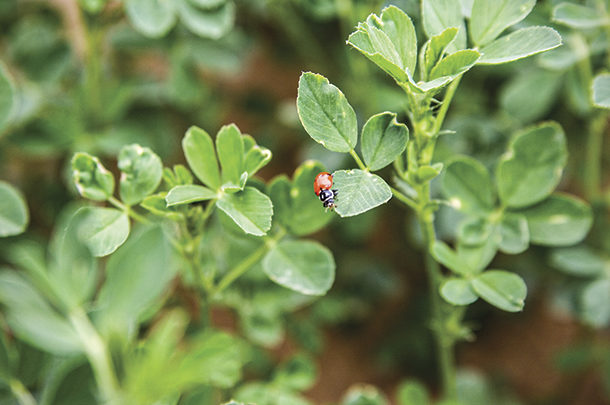Will Ricks had a big problem with aphids in his alfalfa. “Aphids can do a lot of damage, especially in large numbers,” he says.
Ricks owns and operates Ricks Hay Farms in Monteview, which is an unincorporated community in Jefferson County in eastern Idaho. He’s been farming for 20 years, and ladybugs recently became a part of his pest-management strategy.
According to Pacific Northwest Pest Management Handbooks, “Aphids are common on legumes. Aphids can frequently cause problems when their natural enemies are eliminated by sprays targeting alfalfa weevil. Border harvesting or strip cutting can help preserve natural enemies for aphids and other pests. Aphids feed by sucking juices from leaves, stems and pods. Large populations reduce plant vigor.
Aphids secrete honeydew that can promote a black, sooty mold and decrease photosynthesis. Aphids may also transmit viruses to alfalfa, including alfalfa mosaic virus and others.” Insecticides often destroy beneficial insects, leading to severe outbreaks of aphids and other pests.
“Aphids are almost always present in alfalfa, and are only occasionally an economic pest,” says Joseph Sagers, University of Idaho Jefferson and Clark County Extension educator. “When populations get large enough, then aphids can be a significant pest in alfalfa. Some years, they can be so devastating that crop yields are cut in half. A normal year’s damage can be seen as wilting plants. Aphid species vary the amount of damage they can do. For example, blue alfalfa aphid causes more damage per aphid than green pea aphid [the most common aphid seen in alfalfa], so the threshold to treat for blue alfalfa aphid is lower, and green pea aphid can be tolerated at higher levels.”
Sagers says, “Natural predators are the best option for keeping aphid populations at bay. Ladybugs can be effective, but they have a limited use, because they are evolved to come out of dormancy and fly far away to find their food. Usually their effectiveness only lasts for a short time around their release. Better options are to encourage parasitoid wasps or natural predator populations already present, but let’s be honest, that’s not as fun or exciting as letting a bunch of ladybugs go. I like to see one predator for every 100 aphids I see, but that is by no means the established threshold. More work needs to be done on the effectiveness of ladybug applications and their effectiveness. Ladybugs can be purchased online at most garden stores.”
According to the Idaho Department of Environmental Quality’s A Guide to Beneficial Insects: As an alternative to using pesticides, “Ladybugs can eat over 5,000 aphids [or 50 aphids per day as an adult] during their lifetime of about a year. Ladybug beetles should be released in late spring [early April to early June], depending on what part of the country you live in. The pests to be controlled must be present, or the ladybeetles have a tendency to leave in search of other food. The release area should be lightly watered before ladybug beetles are released near dusk.” The department also recommends soil temperature should be at least 50ºF to 55ºF at the time of release.
“I learned about ladybugs controlling aphids in college,” says Ricks. He graduated from Ricks College with a degree in crop science. He then transferred to Utah State University where he became a “true Aggie.” Ricks graduated with a bachelor’s in ag business in 1999.
“We’ve been spraying for aphids for at least 15 years, and we’ve been spreading ladybugs for the last three years,” Ricks says. The ladybugs come from a company in Arizona.
When the ladybugs arrived, Ricks shook them out on the alfalfa around the pivot center, and they migrated through the field. He says he hasn’t had to spray for aphids in three years, since he began this practice. “The ladybugs seem to stay in the pivots where we place them,” he says. The lifespan of a ladybug is two to three years.
Ricks produces 3/4-ton bales of alfalfa (8,000 tons), timothy (1,000 tons) and straw (1,000 tons) for dairy, export, feeder and horse markets. “We also feed out 900 head of cattle,” he says.
The Idaho Hay and Forage Association was formed in 1995, and Ricks has been president for seven years. “One goal we had as a hay association was to be involved at a federal level, and we’ve been able to do that through the National Alfalfa Forage Alliance. They’ve been able to give alfalfa a presence in Washington, D.C. that we’ve never had before. One of our members is on the board of NAFA (National Association for Fixed Annuities).” Ricks says he will continue to serve as president of the hay association.
“My greatest achievement, and what I’m most proud of, are my children. I think the biggest factor for going into agriculture was the desire to raise my kids on the farm. They learn to work and gain many other life skills from being raised on the farm.” Ricks and his wife, Angie, have six children. He said, “She does the books. We have a hay press business and ship it overseas to China. It has been going on a couple years now. We have been building it up since November.”
“I am ‘ag proud’ because it’s not an easy lifestyle, but it’s a great way to raise a family, and we can be proud that we feed the world,” he says. ![]()
Getty Images.
Kimberly Williams Brackett is a freelance writer based in Idaho.








